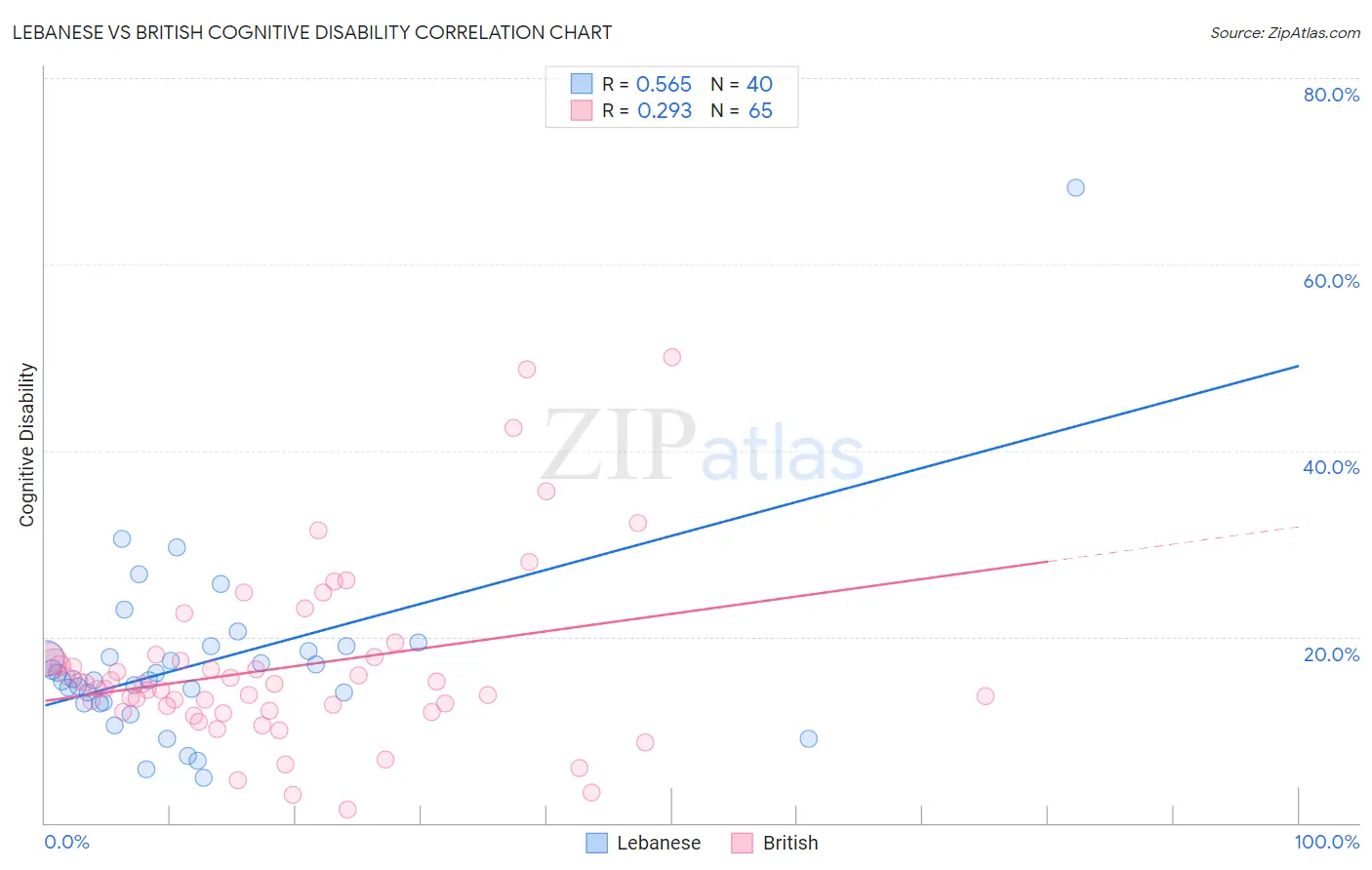Lebanese vs British Cognitive Disability
COMPARE
Lebanese
British
Cognitive Disability
Cognitive Disability Comparison
Lebanese
British
17.0%
COGNITIVE DISABILITY
91.3/ 100
METRIC RATING
135th/ 347
METRIC RANK
17.0%
COGNITIVE DISABILITY
89.3/ 100
METRIC RATING
143rd/ 347
METRIC RANK
Lebanese vs British Cognitive Disability Correlation Chart
The statistical analysis conducted on geographies consisting of 401,594,018 people shows a substantial positive correlation between the proportion of Lebanese and percentage of population with cognitive disability in the United States with a correlation coefficient (R) of 0.565 and weighted average of 17.0%. Similarly, the statistical analysis conducted on geographies consisting of 531,402,976 people shows a weak positive correlation between the proportion of British and percentage of population with cognitive disability in the United States with a correlation coefficient (R) of 0.293 and weighted average of 17.0%, a difference of 0.16%.

Cognitive Disability Correlation Summary
| Measurement | Lebanese | British |
| Minimum | 4.9% | 1.5% |
| Maximum | 68.2% | 50.0% |
| Range | 63.4% | 48.5% |
| Mean | 17.2% | 16.7% |
| Median | 15.4% | 14.9% |
| Interquartile 25% (IQ1) | 12.9% | 12.0% |
| Interquartile 75% (IQ3) | 18.7% | 17.7% |
| Interquartile Range (IQR) | 5.9% | 5.7% |
| Standard Deviation (Sample) | 10.1% | 9.5% |
| Standard Deviation (Population) | 10.0% | 9.4% |
Demographics Similar to Lebanese and British by Cognitive Disability
In terms of cognitive disability, the demographic groups most similar to Lebanese are Israeli (17.0%, a difference of 0.030%), Immigrants from Norway (17.0%, a difference of 0.030%), Immigrants from Chile (17.0%, a difference of 0.040%), Welsh (17.0%, a difference of 0.050%), and Immigrants from Jordan (17.0%, a difference of 0.060%). Similarly, the demographic groups most similar to British are Immigrants from Brazil (17.0%, a difference of 0.0%), Carpatho Rusyn (17.0%, a difference of 0.020%), French (17.0%, a difference of 0.050%), Chilean (17.0%, a difference of 0.050%), and Aleut (17.0%, a difference of 0.050%).
| Demographics | Rating | Rank | Cognitive Disability |
| Immigrants | Uruguay | 92.9 /100 | #129 | Exceptional 17.0% |
| Immigrants | Vietnam | 92.4 /100 | #130 | Exceptional 17.0% |
| Immigrants | Germany | 92.1 /100 | #131 | Exceptional 17.0% |
| Whites/Caucasians | 92.1 /100 | #132 | Exceptional 17.0% |
| Immigrants | Jordan | 91.9 /100 | #133 | Exceptional 17.0% |
| Immigrants | Chile | 91.7 /100 | #134 | Exceptional 17.0% |
| Lebanese | 91.3 /100 | #135 | Exceptional 17.0% |
| Israelis | 91.0 /100 | #136 | Exceptional 17.0% |
| Immigrants | Norway | 90.9 /100 | #137 | Exceptional 17.0% |
| Welsh | 90.8 /100 | #138 | Exceptional 17.0% |
| French | 90.0 /100 | #139 | Excellent 17.0% |
| Chileans | 89.9 /100 | #140 | Excellent 17.0% |
| Aleuts | 89.9 /100 | #141 | Excellent 17.0% |
| Carpatho Rusyns | 89.6 /100 | #142 | Excellent 17.0% |
| British | 89.3 /100 | #143 | Excellent 17.0% |
| Immigrants | Brazil | 89.3 /100 | #144 | Excellent 17.0% |
| Immigrants | South Eastern Asia | 88.7 /100 | #145 | Excellent 17.0% |
| Costa Ricans | 88.0 /100 | #146 | Excellent 17.0% |
| Scotch-Irish | 85.9 /100 | #147 | Excellent 17.1% |
| French Canadians | 85.7 /100 | #148 | Excellent 17.1% |
| Cypriots | 85.7 /100 | #149 | Excellent 17.1% |